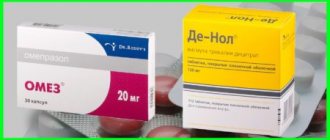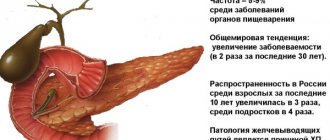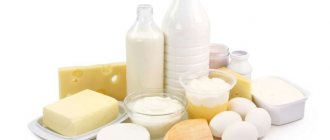GastrituNet.ru » Stomach diseases » Gastritis » Treatment » Drugs
Diseases of the gastrointestinal tract, such as gastritis, ulcers, gastric acidity syndrome and others, are accompanied by severe pain in the epigastric region. Therefore, the treatment regimen often contains painkillers for gastritis and other pathologies, designed to relieve pain.
- 1 Pain relief for gastritis and ulcers
- 2 Types of drugs
- 3 Treatment of pain due to high acidity
- 4 Treatment of pain due to low acidity
- 5 Antacids
- 6 Antispasmodics
- 7 Contraindications to drugs
- 8 Traditional medicine
- 9 When should you not take pain relief?
Is it possible to endure pain?
Many people believe that pain can be endured. However, in reality this is not worth practicing. After all, pain is a natural impulse and reflex of the human body, which occurs as a reaction to various irritating factors. This is the body's way of saying that it feels bad and needs help. Accordingly, pain cannot be tolerated; it is imperative to look for the reasons for its development and ways to eliminate it.
But more often than not, people try not to endure the pain, but to immediately suppress it with painkillers. Fortunately, the modern pharmaceutical industry offers a huge number of non-steroidal anti-inflammatory drugs, which are available in pharmacies without prescriptions. However, many people, when starting to take these types of drugs, forget that painkillers can be dangerous to health. And with their regular use, including beyond the prescribed course, such medications can undermine health even more.
What are the dangers of painkillers?
A lot of research has been carried out that has led to an interesting discovery. It turns out that even seemingly harmless ibuprofen or paracetamol can cause serious problems in the human body. For example, it was proven that those who took such drugs regularly 6 or 7 days during the week increased the likelihood of developing hypertension. This is due to the fact that most non-steroidal anti-inflammatory drugs, which are often widely used in the form of publicly available painkillers, inhibit the production of prostaglandins E2 and I2, which have a vasodilating effect. As a result, filtration in the renal glomeruli is significantly reduced, which can lead to fluid retention in the body and increased blood pressure. And this, in turn, entails the risk of heart attacks or strokes, as well as kidney failure.
Another problem that develops while taking analgesics is the risk of blood clots. To reduce the negative effect of painkillers in cases of gastrointestinal problems when the important enzyme cyclooxygenase-1 is blocked, NSAID drugs have been developed that primarily block another enzyme involved in the development of inflammation and the pathogenesis of pain: cyclooxygenase-2. However, this had the opposite effect. Such painkillers do not cause stomach problems and do not cause bleeding, because the platelets responsible for stopping bleeding do not contain COX-2, but this fact contributes to increased platelet aggregation and the formation of blood clots. This increases the likelihood of thrombosis, myocardial infarction and ischemic stroke. In this case, those who have varicose veins, atherosclerosis, and diabetes mellitus should be especially careful.
Liver problems and photodermatosis may also occur. As a result, a person will notice swelling, redness of the skin, and rashes, which will develop against the background of even short-term exposure to the sun.
Also, against the background of excessive intake of such drugs,:
- Noise in ears;
- Intestinal disorders;
- Deposition of calcium salts in the kidneys;
- Migraine;
- Nervous disorders;
- Disturbances in bone marrow activity.
Analgin
The most famous analgesic, reduces body temperature and inflammation. It is prescribed in the same way as paracetamol - after surgical interventions (in injection form), for renal and hepatic colic, traumatic injuries and bruises.
Release form: tablets and solution for injection. Included in the lytic mixture (together with papaverine and diphenhydramine) - an urgent need to reduce temperature or relieve pain.
Contraindicated for up to 3 months, for pregnant and lactating women, for severe liver and kidney damage. Not compatible with alcohol. Adverse effects include the ability to reduce blood pressure and cause allergies.
Underwater rocks
When taking painkillers, you need to consider a number of simple nuances. First, medications relieve pain but do not affect the cause of the pain. And reducing pain leads to such a problem as blurring the symptoms of a particular disease. This situation can be extremely dangerous, for example, with appendicitis, when literally every minute is precious. Incorrectly selected analgesics and drugs used excessively can cause asthma, allergies or even seizures. An overdose of some substances can cause death.
Therefore, you should not abuse such means. If you have severe pain, you should consult a doctor as soon as possible and find out the cause of this situation.
Painkillers can have a detrimental effect on the gastrointestinal tract, so you should think in advance about how to protect the stomach when taking non-steroidal drugs to prevent gastrointestinal diseases.
It is important to understand that actions should be taken only after consulting a doctor.
Papaverine for gastritis
Papaverine is an antispasmodic drug that is actively used to reduce the contractile function of smooth muscle fibers and reduce muscle tone, which leads to rapid relaxation of smooth muscles. Prescribed to eliminate spasms of the biliary tract, ureters, gastrointestinal tract, and decrease the tone of the uterus.
To obtain a stable and high-quality effect from therapy, the medicine is injected under the skin, intravenous and intramuscular injections are allowed. The dosage and duration of therapy depends on the target patient group.
For children, adolescents over 14 years of age, and adults, the initial dosage is 0.5-2 ml at a time. The first time, the medicine is administered through the veins, slowly. The average speed is 3-5 ml per minute. Optimal concentration of the drug: 1 ml of active substance (20 mg at 2% solution) in a prepared solution of sodium chloride (0.9%).
For elderly patients, for initial therapy, 10 mg of the active ingredient at a time is sufficient. Additional monitoring of the person’s condition is required (over 75 years of age). If symptoms of hyperthermia occur, emergency ventilation and oxygenation are performed. In advanced and emergency cases, dialysis is practiced.
Papaverine tablets have a bitter taste and are available in two dosages – 10 and 40 ml
When taking papaverine, elderly patients experience hyperventilation, severe ataxia, collapse of the lungs and cardiovascular system. High doses of medication, especially when administered rapidly through a vein, provoke arrhythmia. In rare cases, atrioventricular block has been recorded. Significant but moderate sedation is observed.
These consequences are eliminated with symptomatic therapy. No specific antidotes or compounds have been found. A complete diagnosis and observation is required in a hospital setting, including daily cardiac monitoring and forced ventilation. The use of this medicine is possible only after consultation with a doctor!
- rectally: the suppository is inserted into the anus (after a cleansing enema or spontaneous bowel movement), having previously freed the suppository from the contour packaging using scissors (cutting the packaging along the contour of the suppository). Use 1-2 suppositories 2-3 times a day;
- injection solution: Papaverine is administered subcutaneously, intramuscularly or intravenously. It is recommended to administer 0.5-2 ml of a 2% solution subcutaneously and intramuscularly to adults and children over 14 years of age. It should be noted that intravenous administration is considered the most effective, but should be carried out very slowly - 3-5 ml/min. Moreover, you first need to dissolve 1 ml of 2% drug in 10-20 ml of 0.9% sodium chloride solution;
- The maximum dosages for adult patients with subcutaneous and intramuscular administration are as follows: a single dose is 5 ml of a 2% solution (i.e. 100 mg), a daily dose is 15 ml of a 2% solution (i.e. 300 mg). For intravenous administration: a single dose is 20 mg (1 ml of a 2% solution), a daily dose is 120 mg (6 ml of a 2% solution);
- tablets : tablets are usually prescribed to children for internal use; they should be taken 3-4 times a day.
What are NSAIDs?
NSAIDs are non-steroidal anti-inflammatory drugs aimed at eliminating the symptoms of acute and chronic pathologies. They exhibit an analgesic effect, relieve inflammation and fever. The mechanisms of action of drugs in this group are aimed at reducing the synthesis of cyclooxygenase, which triggers protective mechanisms in response to pathological processes. Inhibition of cyclooxygenase synthesis leads to suppression of the synthesis of prostaglandins, the most important products of the inflammatory process.
The most famous representative is acetylsalicylic acid or aspirin. Ibuprofen, analgin, movixicam, and ketorolac are widely used. NSAIDs are effective for pain of moderate and mild intensity.
NSAIDs are classified as selective or non-selective. The first group includes drugs that block cyclooxygenase-2 to a greater extent. Non-selective ones block both forms of COX, producing a pronounced systemic effect. Selective NSAIDs are safer for the digestive tract.
Dexalgin
The medicine belongs to non-steroidal analgesics. It is used to relieve pain of moderate to mild intensity. The medicine also relieves inflammation and has a moderate antipyretic effect. The active component, dexketoprofen, reduces the synthesis of prostaglandins and suppresses pain receptors. Dosage form: injections and tablets.
Advantages:
- has a combined effect on the body: relieves inflammation, fever and pain;
- after half an hour it begins to act;
- improves the patient's condition;
- the effect of the medicine can last up to 6 hours;
- well tolerated.
Flaws:
- not suitable for long-term therapy;
- there are contraindications: bronchial asthma, hypersensitivity, liver, heart, kidney diseases, pregnancy, lactation.
Mechanisms of negative impact
There are several mechanisms for the development of NSAID gastropathy:
- inhibition of the synthesis of the enzyme cyclooxygenase;
- direct toxic effect;
- systemic toxic effect.
It is the first mechanism that is of primary importance. As a result of inhibition of the synthesis of protective prostaglandins, the production of cyclooxygenase decreases. Prostaglandins, blocked by NSAIDs, regulate bicarbonate secretion and local blood flow. Bicarbonates, contained in gastric mucus and produced by local glands, protect the mucous membranes of the stomach from the irritating effects of hydrochloric acid and chemicals that penetrate the gastrointestinal tract.
Symptoms of gastrointestinal tract damage while taking NSAIDs
Clinical manifestations of gastritis during treatment with non-steroidal drugs vary from patient to patient. In half of the cases, the disease occurs without any symptoms. It is possible to diagnose gastropathy only at the stage of development of complications.
The following symptoms are noted:
- feeling of heaviness in the stomach;
- nausea;
- pain in the epigastric region;
- poor appetite;
- flatulence.
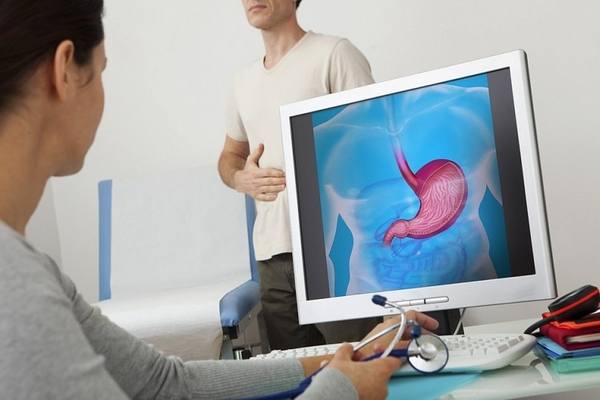
How to protect your stomach?
The mucous membrane, devoid of bicarbonates and mucus, is susceptible to the toxic effects of chemicals. Therefore, to prevent complications and the development of NSAID gastropathy, it is necessary to follow these rules:
- give up alcohol and smoking, which have a detrimental effect on the gastroduodenal lining;
- take the tablets with meals with a glass of water;
- do not increase the dosage on your own;
- Do not take medications for more than two weeks.
Means for protecting the mucous membrane
To protect the stomach when taking NSAIDs, it is necessary to additionally take drugs that stimulate the protective mechanisms of the mucous membranes of the stomach and upper intestines. Such drugs include:
- Celecoxib;
- Celebrex;
- Omeprazole;
- Omez;
- Ranitidine;
- Cimetidine;
- Famotidine.
These drugs block histamine receptors in the epithelial layer of the gastric mucosa and reduce the passage of hydrochloric acid. Usually used to treat diseases of the digestive tract with high acidity.

Effective analgesics
Metamizole sodium is an effective analgesic. This substance is part of such drugs as analgin, baralgin and other algins. These drugs are the most unsafe.
Metamizole sodium is banned in different countries of the world. This medicine can only be used once and only in strictly prescribed doses. With prolonged use (more than three days), serious side effects may develop, which is why these drugs are prohibited.
Acetylsalicylic acid is also effective, but unsafe, as it damages the mucous membrane. Therefore, this remedy is strictly contraindicated for those whose stomach is a weak point. To reduce the irritating effects of this acid, choose coated tablets that will dissolve only in the intestines, as well as effervescent tablets that dissolve first in water.
Aspirin should be taken only after meals and with plenty of water. You should not drink it if you have ARVI and influenza, chickenpox and other viral infections, as Reye's syndrome may occur (mainly in children), which destroys the nervous system and liver. In people prone to allergies, acetylsalicylic acid can cause aspirin asthma. Never dissolve aspirin - the toothache will not go away, but you may get irritation of the gums and mouth.
Prevention of gastropathy
To prevent drug-induced gastropathy, it is necessary to take painkillers only as prescribed by a doctor and strictly in the dosages prescribed by him. During therapy, you need to avoid foods that irritate the mucous membranes of the stomach: spicy, fatty foods, fast food, strong drinks. Eating very hot or cold food is not recommended.
Additional intake of protective drugs will protect the stomach when taking NSAIDs. Among the traditional methods, it is recommended to drink aloe juice on an empty stomach with water or honey, linden honey and propolis. All methods must first be discussed with your doctor.
Strong modern analgesics
Codeine is a strong pain reliever. It is added in small quantities to analgesics against severe pain:
We invite you to read: The tongue is covered with a white coating, what does this mean?
• pentalgin;
• solpadeine;
• caffetine;
• nurofen plus.
It is classified as a narcotic analgesic, so people with mental disorders may develop addiction with prolonged use of this substance. Codeine also often causes drowsiness and constipation. It can only be used as a one-time emergency remedy.
Triptans are also used for pain relief. They selectively narrow dilated blood vessels during migraines. This painkiller is strong enough that only one tablet is always enough. If you have cardiovascular diseases, you should definitely consult a cardiologist before taking it.
Drug interactions
The combination of non-steroidal anti-inflammatory drugs with the following groups of drugs is not recommended:
- sulfonylurea derivatives;
- indirect anticoagulants;
- digoxin, aminoglycosides;
- methotrexate, phenytoin;
- lithium preparations;
- beta blockers, diuretics, ACE inhibitors;
- triamterene.
Before using any additional products, you should consult your doctor to prevent adverse reactions and serious conditions.
Actions in case of overdose
Symptoms of an overdose of anti-inflammatory drugs include nausea, vomiting, and trembling of the limbs. Possible black stools, vomiting blood, clouding of consciousness. In case of severe vomiting of blood and loss of consciousness, you should immediately seek medical help.
In case of asymptomatic overdose, activated carbon is used. In other cases, treatment is symptomatic.
Myths that we encounter in daily practice
Myth 1. Using NSAID drugs in the form of suppositories is less aggressive for the stomach than taking pills
This is 100% a myth. The pathogenic, destructive effect of the drug is realized through the blood, delivering it through the vessels to the stomach.
Myth 2. Medicines from the group of antacids - Rennie, Maalox, Phosphalugel and H2-blockers (Ranitidine and Famotidine) can be used as “gastroprotectors”
In this case they are not effective.
Myth 3. You can't take proton pump inhibitors regularly
The fact is that if an elderly person has been prescribed an anti-inflammatory drug for life, it is absolutely pointless to prescribe gastroprotection for a month. In such cases, medications should be taken strictly in parallel.
Myth 4. Food products (jelly, etc.) can act as “gastroprotectors”
We will leave this myth as absolutely fantastic without comment.
Reviews from doctors and patients
“Non-steroidal anti-inflammatory drugs are a powerful tool in the hands of a doctor, helping to alleviate the patient’s condition quickly and easily. But only a competent approach will help not harm the digestive system. If the doctor claims that protection is not needed, it is better to choose another doctor.”
Anatoly Fedorovich, therapist, Komsomolsk-on-Amur
“NSAIDs help quickly eliminate pain and inflammation - the best solution for osteochondrosis and arthrosis.
But I prescribe them only in cases of acute pain for a short period of time - up to five days. This is enough to relieve exacerbation and prevent damage to the gastrointestinal tract.”
Anna Nikolaevna, vertebrologist, Moscow
“For constant back pain, only NSAIDs help and, unfortunately, I have already developed gastritis and ulcers. We treat it with other medicines, this time for the stomach, so far it helps. And this despite the fact that I am not yet thirty, I was simply not warned in time about the danger of uncontrolled use of painkillers - I took them longer than was prescribed.”
Victoria, Vologda
“After surgery on the maxillary sinus, half of my face hurt badly. There was simply nowhere to give injections, so she asked me to prescribe painkillers in tablets. I took Dexalgin according to the following scheme: eat, after half an hour drink Omez, after another half hour - Dexalgin. The stomach remained normal.”
Among the most common symptoms in humans is stomach pain. It can be triggered by various functional or organic disorders in the digestive system. To avoid discomfort, you need to take painkillers. Different groups of drugs have an analgesic effect, so it is worth studying them in order to choose a specific drug.
Ketanov
The drug is a powerful non-steroidal analgesic that is used for severe and moderate pain.
The active component, ketorolac, inhibits the synthesis of prostaglandins, which modulate pain sensitivity, inflammation and thermoregulation.
Indications: pain during oncology, tooth extraction, fractures, bruises, soft tissue damage, menstruation; postoperative period, after childbirth, etc. Available in the form of a solution and tablets.
Advantages:
- refers to potent painkillers and has a wide range of uses;
- there is no dependence;
- the potency of action is comparable to morphine, but unlike it does not have sedative, anxiolytic effects, and also does not depress the respiratory system;
- is an excellent analogue of opioid analgesics;
- fast action - in a quarter of an hour.
Flaws:
- side effects: nausea, anxiety, loss of energy, nervousness, rapid heartbeat;
- not suitable for eliminating chronic pain;
- contraindications: age under 16 years, hypersensitivity, lactation, pregnancy, stomach ulcer, bronchial asthma, etc.
Causes of stomach pain
To find out the cause of abdominal pain, you will need to undergo an examination, since many diseases or disorders in the gastrointestinal tract (GIT) can cause such a symptom. The provoking factor is overeating or, conversely, hunger. In the latter case, the pain is cutting and pulling. It is relieved not with medications, but simply by eating, but first in small portions, because you can’t overeat either.
Another common cause of abdominal pain is food poisoning, which is also accompanied by diarrhea, vomiting and fever. Poor nutrition also causes stomach problems: burning, cramping, heartburn, and a feeling of heaviness. Some diseases can also cause abdominal pain:
- Gastritis. Accompanied by heartburn, diarrhea, severe pain, cramps.
- Ulcer. It reminds you of itself by belching, aching pain, increased gas formation, and nausea.
- Gastric hypersecretion. Causes abdominal discomfort, nausea, heartburn, infrequent constipation, sour belching, flatulence.
- Neoplasms of a benign or malignant nature.
- Ahilia. With this disease, there is no hydrochloric acid and digestive enzymes in the gastric juice. Characteristic symptoms are allergies, dysbiosis, bloating, gastric reflux, and decreased appetite.
- Gastroesophageal reflux. This is the reflux of food from the stomach into the esophagus. In addition to pain, the disease causes destruction of tooth enamel, painful swallowing, regurgitation, heartburn, and prolonged cough.
Groups of painkillers for the stomach
Nonsteroidal anti-inflammatory drugs based on acetylsalicylic acid, ibuprofen and diclofenac are prohibited for abdominal pain. Their uncontrolled use can lead to gastritis, duodenal or stomach ulcers. The following are allowed for stomach pain:
- Antacids. These drugs not only relieve abdominal pain, but also treat the cause of its occurrence. They are alkaline, so they interact with the acidic environment of the stomach.
- Antispasmodics. This is the most common group of painkillers for the stomach, the action of which is aimed at relieving spasms of smooth muscles.
- Proton pump blockers. They act at the cellular level, block the synthesis of hydrochloric acid by parietal cells, protecting them from an acidic environment.
- Histamine receptor blockers. These drugs stabilize the production of prostaglandins, gastric mucus, pepsin and bicarbonates.
- Bismuth-containing preparations. Their main purpose is to treat ulcers. This group of drugs exhibits bactericidal activity against Helicobacter pylori.
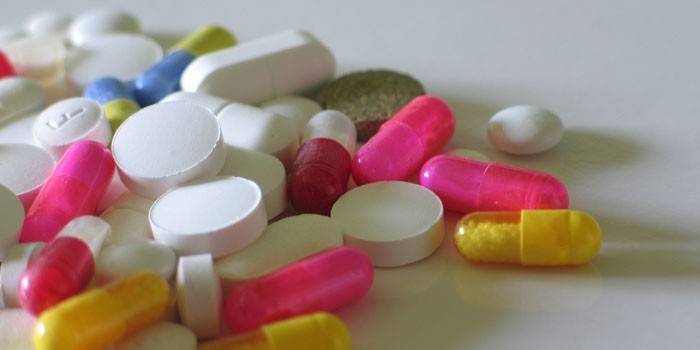
Antacids
The effect of antacid drugs is to neutralize the acidity of gastric juice and coat the mucous membrane. This helps relieve pain, eliminate heartburn and activate recovery processes. Modern antacid medications contain aluminum and magnesium salts, which increase the effectiveness of these medications. Their main advantage is the minimum of contraindications:
- renal failure;
- individual intolerance to individual components.
The last contraindication concerns magnesium oxide, calcium carbonate, aluminum hydroxide, sodium bicarbonate. These substances are classic active components of antacids. Preparations based on them are used to treat:
- gastritis with high acidity;
- reflux disease, in which stomach contents flow back into the esophagus.
Another advantage of antacids is their local effect. These drugs are not absorbed into the systemic circulation, which is why they have virtually no side effects. Some antacids are capable of adsorbing toxins, so such tablets for stomach pain are also used in cases of food poisoning. Effective drugs in this category are:
Antispasmodics
These are painkillers for gastritis and stomach ulcers. Additionally, antispasmodics help eliminate unpleasant symptoms of gastroesophageal reflux. The main effect of such drugs is to regulate the contractile function of muscles, which helps eliminate their involuntary spasms. This effect is achieved in different ways depending on the type of antispasmodics used:
- Neurotropic. They act on nerve impulses and stimulate muscle function. Suppression of spasm is due to blocking the pain signal. Neurotropic antispasmodics are M-anticholinergics: Methocinium, Hyoscyamine, atropine sulfate, Buscopan.
- Myotropic. They influence biochemical reactions inside muscle cells, which also provides relief from spasms. Papaverine, Spasmomen, Trimedat, Papazol, Drotaverine, No-shpa have this effect.
Antispasmodics for the stomach include both pharmacological tablets and herbal remedies. The latter contain extracts of medicinal herbs: chamomile, oregano, tansy, lily of the valley, mint, belladonna. Both groups of drugs have minimal contraindications:
- enlarged colon;
- certain types of colitis;
- microbial intestinal diseases;
- tuberculosis;
- Crohn's disease.
Proton pump blockers
Proton pump inhibitors or blockers help relieve heartburn. This effect is due to blocking the secretory function of the parietal cells of the stomach, which produce hydrochloric acid. After taking proton pump inhibitors, the processes of regeneration of the digestive system function are started. Additionally, these drugs protect the mucous membrane from high acidity. They are used as pain relievers for stomach ulcers, gastritis, and esophageal reflux. Popular among proton pump blockers are:
When treating chronic ulcers, they are more effective in combination with antibiotics. After taking proton pump inhibitors, disorders of the visual analyzer are possible, which is often manifested by a decrease in visual acuity. Possible muscle pain, depression, changes in the leukocyte formula. Proton pump blockers have a minimum of contraindications:
- pregnancy;
- lactation;
- malignant tumors of the digestive tract;
- liver and kidney failure;
- gastrointestinal infections.
Papaverine for gastritis for pregnant women
The safety of using Papaverine during pregnancy and breastfeeding has not been established. It is prescribed by a doctor if the benefit to the mother is greater than the possible harm to the child, usually in critical situations. During pregnancy, the drug is prescribed exclusively in the form of suppositories. There are known cases of use during uterine hypertonicity, with the threat of miscarriage or premature birth.
When treating pregnant women, Papaverine in tablet form is used very rarely.
The doctor prescribes the drug in combination with other drugs. The effect of the suppositories is achieved quickly; when introduced into the uterus, the spasm is relieved within the first hour of action. The daily norm is no more than four candles. Increase in concentration only when prescribed by a doctor. During pregnancy, Papaverine increases the chances of bearing a child with hypertension.
Contraindications for the use of papaverine during pregnancy:
- thyroid diseases;
- tachycardia;
- liver dysfunction;
- increased eye pressure;
- bronchial obstruction syndrome;
- hypersensitivity to the components of the drug.
When treating pregnant women, Papaverine in tablet form is used very rarely.
Papaverine injection solution for gastritis for pregnant women
To achieve an immediate therapeutic effect, injections are used: intravenously or intramuscularly. When administered intravenously, the medicine immediately enters the bloodstream and acts instantly. The effect of intramuscular injections occurs a little later, but still much faster than when using tablets or suppositories.
If, upon examination, the doctor discovers a threat of termination of pregnancy, the woman is admitted to the hospital and she is prescribed intramuscular or intravenous injections of Papaverine. Papaverine is administered intravenously very slowly. This procedure can only be performed by a specialist - a doctor or nurse.
The woman’s condition will improve significantly within a short period of time after the injection. The expectant mother will feel calmer, and her heart will begin to beat more slowly.
Papaverine suppositories for gastritis for pregnant women
Papaverine rectal suppositories are prescribed to a pregnant woman if the threat of miscarriage is insignificant. Suppositories are used for home treatment and are used as a storage element that maintains the constant condition of the uterus. An improvement in a pregnant woman's condition occurs a few minutes after use: the stomach becomes soft, the pain recedes, and the muscles relax.
Use of papaverine suppositories at different stages of pregnancy:
- first trimester: suppositories with papaverine during early pregnancy are used in case of increased uterine tone. You should not start using the drug without a medical prescription, so as not to provoke side effects.
- second trimester: the drug papaverine in the form for rectal administration in the second trimester is prescribed for abdominal pain, increased blood pressure and in the presence of other indications that have already been listed above. At this stage, not only papaverine is used, suppositories for pregnant women are combined with other medications, depending on the clinical situation;
- third trimester: in the later stages of pregnancy, it is rational to use papaverine in case of excessive tone of the uterine walls. Also, closer to the preliminary date of birth, the medication is prescribed to prepare the cervical canal for opening. At the beginning of labor, the drug helps reduce the intensity of pain during contractions.
Some cases of the use of painkillers for the stomach
You need to be especially careful when choosing painkillers during pregnancy. In the 2nd and 3rd trimester, pain syndrome is caused by spasms of smooth muscles due to the growth of the uterus, which displaces other organs in the abdominal cavity. For this reason, pregnant women are prescribed antispasmodics:
- Drotaverine - in tablets or ampoules;
- Papaverine - in suppositories.
These medications for pain in the stomach and intestines belong to the over-the-counter group, but they cannot be taken without a doctor’s prescription. Antispasmodics have contraindications: severe pathologies of the heart, liver, kidneys. Papaverine is not used for:
- traumatic brain injuries;
- glaucoma;
- kidney and liver diseases;
- hypothyroidism;
- pathologies of the adrenal glands.
Patients with stomach ulcers should also use certain stomach pain relievers. The first-line drugs of choice are proton pump inhibitors based on omeprazole. Additionally, for ulcers the following is prescribed:
- antacids, but their effectiveness against such a disease is limited;
- antibiotics if Helicobacter pylori is detected during a special test.
If the pain is too acute, then in most cases it is caused by increased acidity. The first aid in this case is antacids. In the future, you can use other painkillers for the stomach: proton pump blockers or histamine receptor blockers, but only in consultation with your doctor. In case of acute pain syndrome, it is necessary to undergo a full examination to find out the etiology of this symptom. Based on the results, the doctor will be able to adjust the therapy.
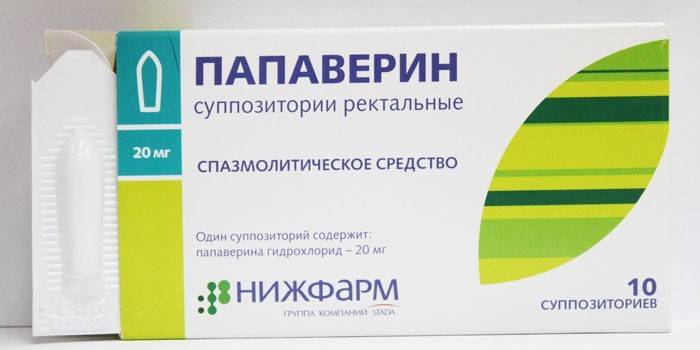
Pain relief for stomach with high acidity
Excessive production of hydrochloric acid contributes to an increase in overall acidity. The pain in this case is of a burning nature, accompanied by constant heartburn. You can get rid of these symptoms only by eliminating their cause, i.e. high acidity. The first-line drugs of choice are antacids, which:
- neutralize hydrochloric acid;
- reduce the activity of peptins;
- envelop the mucous membrane;
- stimulate the synthesis of protaglandins and mucus;
- restore damaged tissues;
- exhibit an analgesic effect.
To relieve pain, 2 groups of antacids are used, which differ in the duration of the effect. Maalox, Almagel Neo, Topalkan, magnesium hydroxide and aluminum hydroxide act for a long time. These products do not change the acid-base balance, but simply neutralize the acid. The instant onset of the effect, but short-term action, is distinguished by:
- Bourget;
- Rennie;
- Tams;
- sodium bicarbonate;
- calcium carbonate;
- magnesium oxide.
Pain relief for stomach with low acidity
If acidity decreases, the pain is accompanied by bloating and heaviness in the abdomen. The reasons are often overeating, poor diet, snacking and the presence of harmful substances in food. The pain is localized in the right side and is accompanied by rotten breath, gas, diarrhea or constipation. The best remedy for relieving these symptoms is nicotinic acid. It contains the following pain relievers for the stomach:
- Analgesics. They have a more powerful analgesic effect. Non-narcotic (Analgin, Acelysin) or narcotic (Morphine, Promedol, Omnopon) analgesics can be used. If you have low acidity, you can also take Ibuprofen, as it increases the secretion of digestive juice.
- Antispasmodics. Reduce muscle tone of the gastric walls. This effect is produced by No-shpa, Baralgin, Papaverine.
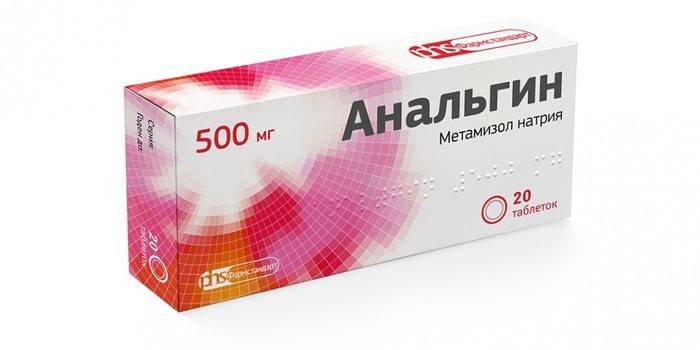
Restrictions on taking medications for stomach pain
If pain is not a constant symptom, then you can cope with it yourself by taking painkillers. When this symptom occurs regularly, you should stop self-medicating and seek help from a doctor. Thus, it is contraindicated to use painkillers for the stomach if:
- severe intoxication;
- nausea and vomiting, especially with blood;
- food poisoning;
- dehydration, which is manifested by dry skin and extreme thirst;
- seizures and other neurological signs;
- drop in blood pressure;
- disorder of consciousness;
- tension of the anterior abdominal wall.
Rating of the best antispasmodics
An effective pain reliever based on drotaverine belongs to the group of myotropic antispasmodics. The drug reduces the tone and motor activity of smooth muscles of internal organs, moderately dilates blood vessels. Like other painkillers of the antispasmodic group, No-shpa helps relieve pain from spasms of the smooth muscles of the bladder, spastic colitis, diseases of the biliary tract and gallbladder, and peptic ulcers. No-shpa also helps with headaches caused by spasm of blood vessels.
Severe renal and liver failure, intolerance to drotaverine are contraindications for use. No-spa almost never has side effects. However, it must be borne in mind that taking pills can cause a severe decrease in blood pressure, headaches and dizziness, increased heart rate, and insomnia. Long-term use may cause constipation and nausea. The maximum single dose of the drug is 2 tablets, the daily dose is 6 tablets. The duration of treatment without consulting a doctor is no longer than 2 days.
Painkillers in tablet form are analgesics of various pharmacological classes that eliminate or relieve pain. They can be called the most popular for humans, since pain accompanies any disease.
Popular painkillers are on everyone's lips. They are widely advertised on television and are present in the home medicine cabinet. Each of them has its own characteristics and common features. It is important to know which ones are best to choose in a particular case.

